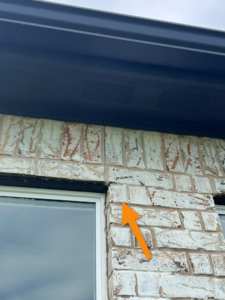Introduction
You’ve found your dream home in Oklahoma City, but during the inspection, you notice cracks in the brick veneer. Should you be worried? This article is your go-to resource for understanding the types of brick veneer cracks, their causes, and the appropriate actions to take. Whether you’re a prospective buyer, a current homeowner, or a real estate professional, this guide will help you make informed decisions and ensure the safety and stability of your property.
Common Types of Brick Veneer Cracks
Expansion Cracking- These cracks happen because bricks and mortar expand and contract with temperature changes. You might see vertical or stair-step cracks. The natural expansion and contraction due to weather conditions cause these cracks. Usually, they are minor. Therefore, keep an eye on them or have a handyman or mason take a look if they get worse.
Lintel-Expansion Cracking- These occur above windows and doors where metal lintels (support beams) expand. Look for horizontal cracks above these openings. Since metal expands more than bricks, this leads to these cracks. Consequently, check the lintels for rust. A mason can handle necessary repairs.
Settlement Cracking- These result from the foundation settling unevenly. Diagonal cracks, often starting from windows or door corners, are common signs. Soil movement under the foundation causes these cracks. In this case, call a foundation professional or structural engineer to assess and fix the problem.
Hairline Cracks- Small, thin cracks in the mortar joints are typical. Fine cracks less than 1/16 inch wide usually result from normal wear and tear or minor shrinkage of mortar. They are generally not serious, but monitor them and have a handyman fix them if needed.
Step Cracks- These follow the mortar joints in a stair-step pattern. They appear as zigzagging through the bricks and often result from foundation movement or poor construction practices. Therefore, a mason or foundation specialist should check these, depending on the severity.
Causes of Brick Veneer Cracking
Poor Workmanship- Sometimes, the way a house is built can lead to cracks. Insufficient mortar or improper curing times often cause these issues. To prevent this, ensure you hire qualified masons and contractors for construction.
Expansion and Contraction- Bricks and mortar expand and contract with temperature and moisture changes, which can cause minor cracks over time. Using expansion joints and proper installation techniques during construction can help manage this.
Insufficient Brick Ties- Brick ties anchor the veneer to the structural wall. Without enough ties, the veneer can move independently and crack. Therefore, ensure proper tie placement during construction.
Structural Settlement- Movement of the soil beneath the foundation affects the structure and causes significant cracks that can indicate serious issues. As a result, a professional evaluation and repair are required for these problems.
A Personal Anecdote
Sometimes, we see an overreaction to typical, minor cracking. I recall one instance where a buyer called to schedule an inspection on a different property than the one we had just inspected for her. Recalling it to be a very clean inspection, I inquired about it. She was concerned about the cracking in the brick. I quickly referenced the report and noticed that it was reported as minor, common cracking with a recommendation to monitor only. During our conversation, I emphasized that it would be difficult to find a home in our area without some type of cracking in the veneer and if she does, there will likely be some cracking in the future. As expected, the second home also had cracking, but we had a focused conversation on the matter and soothed her fears.
Addressing Homeowners Directly
You might have noticed a few cracks in your brick veneer and wondered if they’re something to worry about. Here’s what you need to know:
When to Call a Professional
Knowing who to call can save time and money. Here’s a quick guide:
- Handyman: For minor cracks and cosmetic repairs.
- Mason: For moderate cracks, especially those in the mortar and bricks.
- Foundation Professional: For cracks indicating possible foundation movement.
- Structural Engineer: For severe or unusual cracks that may indicate structural problems.
Conclusion
Cracks in brick veneer can be concerning, but understanding the type and cause can help you decide the best course of action. Whether it’s a minor fix or a significant repair, knowing when to call a professional is key to maintaining your home’s integrity. With very few exceptions, brick is not a structural component in residential construction in the Oklahoma City area. It is simply a type of siding material.
Need a thorough home inspection or have concerns about your brick veneer? Contact Redbud Property Inspections today for expert advice and detailed inspections.
Addressing Homeowners Directly
You might have noticed a few cracks in your brick veneer and wondered if they’re something to worry about. Here’s what you need to know:
When to Call a Professional
Knowing who to call can save time and money. Here’s a quick guide:
- Handyman: For minor cracks and cosmetic repairs.
- Mason: For moderate cracks, especially those in the mortar and bricks.
- Foundation Professional: For cracks indicating possible foundation movement.
- Structural Engineer: For severe or unusual cracks that may indicate structural problems.
Conclusion
Cracks in brick veneer can be concerning, but understanding the type and cause can help you decide the best course of action. Whether it’s a minor fix or a significant repair, knowing when to call a professional is key to maintaining your home’s integrity. With very few exceptions, brick is not a structural component in residential construction in the Oklahoma City area. It is simply a type of siding material.
Need a thorough home inspection or have concerns about your brick veneer? Contact Redbud Property Inspections today for expert advice and detailed inspections.






